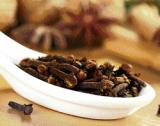Aromas of spice, mainly clove
The first thought on anyone’s mind when pain conquers the dental surface in the middle of the night, is the humble clove. Ever wondered why? A quick search on the Internet tells me that cloves contain an active ingredient called eugenol. Eugenol is an analgesic, anaesthetic and antimicrobial in nature — which is probably why our grandmothers used to store this little magical bud in their secret spice rack.
Known by different names, Laung in Hindi, Lavanga in Kannada, Grambu in Tamil, cloves are believed to have been known to man 2,500 years ago. Many experts attribute the earliest archaeological evidence of cloves in Syria, where archaeologists found a clove in a ceramic vessel. Cloves are believed to have originated in the Moluccas Island of Indonesia but has since moved to India, Madagascar, Zanzibar island of Tanzania and Sri Lanka. According to the encyclopedia, the clove gets its name from the French word ‘clou’ which means small irregular shaped nails.
Used whole or in powdered form, cloves are dried unopened flower buds. They don’t have a stand-alone taste like dhania powder (coriander). They do, however, have a remarkable blending property, which is what makes it a special spice. The trick is to preserve its flavour and aroma. In its powdered form, cloves tend to lose its flavour and scent rather quickly. So it is best to powder and use as and when required. Also, experts suggest a little test before buying it. Press the clove with a finger nail. If it releases oil, then, you can be assured that it is fresh.
The flavour of these flower buds have not just enchanted millions but have also made sure that they remain indispensable in every household. Clove is used in pulav, masala chai and boondi laddus. It is used in a host of other masalas that get prepared in the kitchen and has hence become a member of the elite ‘Indian Masala Club’.
That is perhaps why, this multi- faceted clove used to be a treasured spice in my mother’s favourite silver spice box long before it became affordable. As they were initially grown only in Indonesia, there was little or no availability of this spice in India, making it a luxury. Legend has it that a clove tree was planted whenever a child was born in the family. Over the years, the humble clove’s flavour and taste has captured the taste buds of people all over the world and has since become a part of many European cuisines as well. From gastric delight to mouth freshener, clove is indeed amazingly multifaceted for its size. During the Han Dynasty in China, people were asked to chew a clove before being presented in front of the Emperor to mask bad breath. Today, cloves are a natural ingredient in many toothpastes and mouthwash.
It is common knowledge that clove is an active member of the ‘home remedies’ tray in any household. It is used to cure cold, a sore throat and is still used as a mouth freshener in most parts of the world. It is used in ayurveda for treating indigestion and respiratory problems. In Europe, it is used for treating a variety of ailments like indigestion, flatulence, nausea, worms, infertility, cough and toothache. Clove oil has been used in medicinal proportions only for its healing properties. If it causes slight discomfort to the stomach, it is advisable to stop. Excessive use is reported to damage kidney. Generally taken, in small proportions, clove is considered safe.
If cloves are used in food and medicine, it is also used in making cigarettes. Kretek or clove cigarettes are often mistaken to be a lot safer than the conventional cigarettes. It has 60 to 80 per cent tobacco and only has 20 to 40 per cent of ground cloves. Studies indicate that it delivers more nicotine and carbon monoxide than conventional ones and is also the gateway to get introduced to the world of smoking.
As the rest of the world discovers the exotic taste spices can emanate, the demand for better spices has become larger. Ever since the English landed on the Indian soil in search of exotic spices, they have been addicted to them.
If the consumption of spices increased, so has their production. Cloves were once regarded native to Indonesia alone. Today, it is grown all over the world. The world’s largest producer and exporter of clove is Zanzibar in Tanzania. Although Indonesia still produces a large quantity of clove, it is mostly consumed by its population. Nearly 30 per cent of the population is known to smoke Kretek.
Even India’s neighbouring island country, Sri Lanka, has reached a record level of clove production.